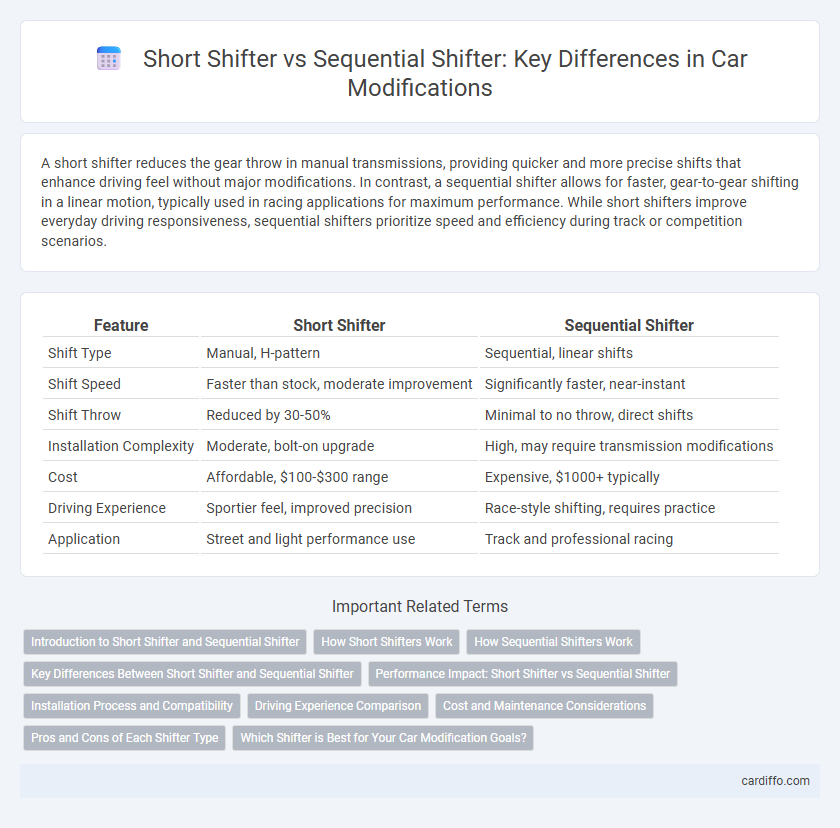A short shifter reduces the gear throw in manual transmissions, providing quicker and more precise shifts that enhance driving feel without major modifications. In contrast, a sequential shifter allows for faster, gear-to-gear shifting in a linear motion, typically used in racing applications for maximum performance. While short shifters improve everyday driving responsiveness, sequential shifters prioritize speed and efficiency during track or competition scenarios.
Table of Comparison
| Feature | Short Shifter | Sequential Shifter |
|---|---|---|
| Shift Type | Manual, H-pattern | Sequential, linear shifts |
| Shift Speed | Faster than stock, moderate improvement | Significantly faster, near-instant |
| Shift Throw | Reduced by 30-50% | Minimal to no throw, direct shifts |
| Installation Complexity | Moderate, bolt-on upgrade | High, may require transmission modifications |
| Cost | Affordable, $100-$300 range | Expensive, $1000+ typically |
| Driving Experience | Sportier feel, improved precision | Race-style shifting, requires practice |
| Application | Street and light performance use | Track and professional racing |
Introduction to Short Shifter and Sequential Shifter
Short shifters reduce the gear lever's travel distance, enabling quicker and more precise gear changes in manual transmissions, enhancing driving performance and responsiveness. Sequential shifters allow gear changes in a linear, step-by-step manner without the traditional H-pattern, commonly used in racing cars for faster, clutchless shifts. Both modifications improve shifting efficiency but cater to different driving styles and requirements, with short shifters favored for everyday sporty driving and sequential shifters suited for competitive track use.
How Short Shifters Work
Short shifters reduce the distance the gear lever travels during shifts by altering the shift linkage geometry, allowing for quicker gear changes and improved driving precision. They work by changing the pivot point or lever arm ratio, which shortens the throw without compromising shift quality or causing excessive wear. Unlike sequential shifters that automate gear selection in a fixed sequence, short shifters enhance manual transmission responsiveness while maintaining driver control.
How Sequential Shifters Work
Sequential shifters operate by engaging gears in a linear sequence, allowing drivers to shift up or down one gear at a time without the need to navigate through the traditional H-pattern. This system uses a ratchet mechanism combined with a shift drum or selector forks to precisely select the next gear, resulting in faster and more consistent gear changes ideal for performance driving. Unlike short shifters, which reduce throw distance within an H-pattern setup, sequential shifters eliminate the chance of mis-shifting by allowing only adjacent gear transitions.
Key Differences Between Short Shifter and Sequential Shifter
Short shifters reduce the gear lever throw distance, enabling quicker manual gear changes without altering the transmission's basic operation. Sequential shifters allow for linear gear selection, making shifting faster and more precise by moving through gears in a specific order rather than an H-pattern. The short shifter is ideal for street driving improvements, while the sequential shifter is preferred in motorsport for rapid, consistent shifts.
Performance Impact: Short Shifter vs Sequential Shifter
A short shifter reduces the distance between gear shifts, resulting in quicker and more precise manual gear changes that enhance driver control and responsiveness in performance driving. A sequential shifter enables rapid, linear gear selection without the need to navigate an H-pattern, significantly reducing shift times and allowing for smoother acceleration in racing environments. While a short shifter improves everyday driving performance with subtle enhancements, a sequential shifter delivers maximum efficiency and speed in competitive motorsports settings.
Installation Process and Compatibility
Short shifters offer a straightforward installation process, often compatible with most manual transmissions without requiring significant modifications. Sequential shifters demand more precise alignment and may require custom mounts or adapters due to their specific gear engagement mechanism. Compatibility with the vehicle's transmission system is crucial in choosing between the two, as sequential shifters are typically designed for race-spec or high-performance setups.
Driving Experience Comparison
A short shifter offers reduced gear throw for quicker, more engaging manual shifts, enhancing tactile feedback and driver connection to the vehicle. Sequential shifters enable faster, clutchless gear changes with precise, linear shifts, ideal for aggressive driving and track use. The short shifter emphasizes improved feel and control for spirited street driving, while the sequential shifter prioritizes speed and shift accuracy for performance-oriented scenarios.
Cost and Maintenance Considerations
Short shifters typically cost less upfront and require minimal maintenance due to their mechanical simplicity, making them a cost-effective choice for performance-oriented drivers. Sequential shifters, while offering faster and more precise gear changes, often involve higher initial investment and increased maintenance complexity because of their intricate design and electronic components. Budget constraints and long-term upkeep preferences play crucial roles when choosing between short shifters and sequential shifters for vehicle modifications.
Pros and Cons of Each Shifter Type
Short shifters reduce gear throw distance, enabling faster shifts and improved driving precision, but they may increase shift effort and cause more drivetrain wear. Sequential shifters provide rapid, clutchless gear changes ideal for racing scenarios, yet they often require specialized transmissions and can compromise everyday drivability. Choosing between short and sequential shifters depends on balancing shift speed, mechanical complexity, and vehicle usage preferences.
Which Shifter is Best for Your Car Modification Goals?
Short shifters provide quicker gear changes by reducing throw distance, ideal for enthusiasts seeking enhanced driving feel and improved shift speed without altering transmission electronics. Sequential shifters enable rapid, linear gear changes suitable for track-focused modifications, offering precision and consistent shifts at high RPMs. Choosing between them depends on your driving style and modification goals: short shifters for street performance and comfort, sequential shifters for competitive racing and aggressive track use.
short shifter vs sequential shifter Infographic

 cardiffo.com
cardiffo.com